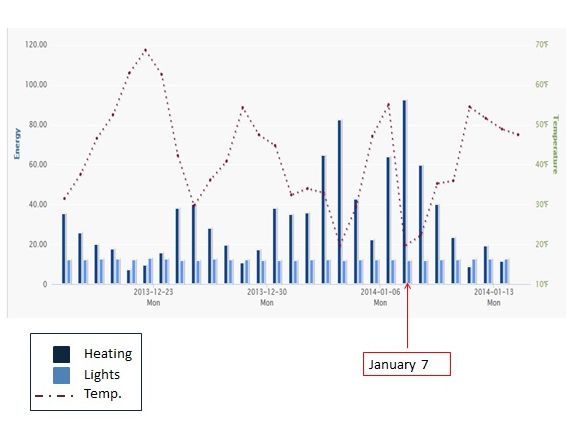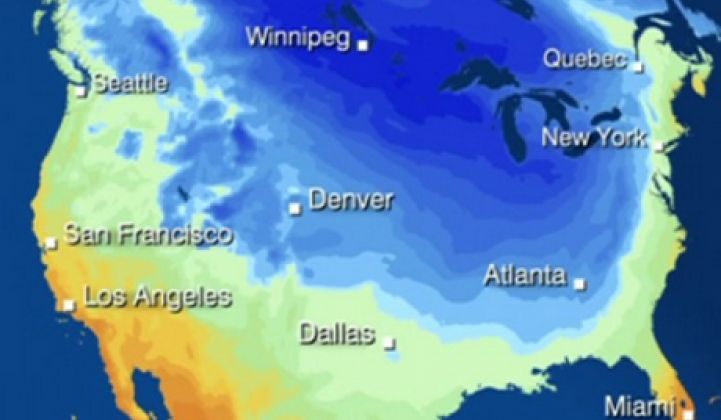This month’s polar vortex racked up business costs in numerous ways: lost work time, closures, delayed deliveries -- and higher energy use and energy-related operational deficiencies.
During the cold snap, Panoramic Power collected energy-use data from more than 4,000 sensors installed at 250 locations across the country. These sensors measure energy at the device level on various systems, including air conditioning, heating, lights and refrigeration.
The more than 5 million data points collected tell a stark tale about the impact of the polar vortex on multi-site retail chains and large-square-footage commercial buildings where Panoramic Power device-level sensors are installed. We saw unusually high levels of energy consumption, high levels of off-hour (i.e., non-business hours) energy consumption, incorrect temperature settings, and even equipment failures.
One common theme that emerged from this data is that the lack of proper energy management strategy contributes to financial losses for American businesses. While the polar vortex affected 80 percent of the country, 10 percent of retail stores examined had heaters or boilers that did not work or that worked inefficiently. There was a 30 percent increase in off-hour energy consumption, mainly due to timer settings that left heating equipment on when nobody was on-site. In addition, excessive energy consumption of 28 percent during operating hours was noticed due to heating equipment inefficiency.
Store Snapshot: Heating vs. Lights
This chart shows a negative correlation between the outdoor temperature and heating consumption. While lighting loads remained the same, peak heating usage dramatically fluctuated, reaching its peak on January 7, 2014.

Areas not accustomed to regular use of heating equipment -- Texas, for example -- showed an astounding 400 percent increase in overall energy consumption. In many cases, device-level monitoring recognized sites that were running both air conditioning and heating at the same time.
One could argue that these particular costs were the result of a one-time, record-breaking storm, but it’s clear that climate change is bringing more severe weather more frequently. Although these particular symptoms were highly amplified during the polar vortex, the same issues are frequently seen during less extreme weather changes. Companies that recognize the value of leveraging their energy as a strategic asset track and analyze their energy use and develop plans to manage weather-related energy use to control costs over time.
Severe weather energy planning: What best-in-class companies need to consider
Device-Level Monitoring: Monitoring devices every 60 seconds provides granular visibility into energy consumption at the system level. Alerts are sent in real time when exceptions occur, when energy thresholds are reached, and when common patterns are not followed. Energy managers can take action during extreme weather when they have their finger on the pulse of energy use and facility performance. They can detect and prevent critical equipment failures in advance while device-level alerts notify them of unusual patterns of off-hour consumption on the fly. A review of the alerts also helps in long-term energy planning.
Granular Data Analysis: The value in understanding energy data cannot be underestimated. Energy data analysis reveals patterns and trends, and delivers actionable intelligence insights about individual electric devices. Assets can then be managed more efficiently in real time.
Continuous Improvement: Continuous improvement is an ongoing effort to improve products, services or processes. Through device-level energy management, an organization can achieve higher operational effectiveness regardless of cold spells or sweltering heat waves. Planned device maintenance activities result in a more efficient use of staff resources and help ensure that devices will run effectively at all times.
Benchmarking Sites and Systems: Prioritizing preventive actions across multiple devices and multiple sites is easily done by benchmarking device data that is compared against industry standards and similar systems. Data can also be compared to other sites within the chain.
As energy costs rise and extreme patterns of hot and cold weather increase, the relatively low-cost investment needed for a device-level energy management solution pays off quickly. An investment in technology that provides transparency and visibility to energy usage across a company’s entire portfolio of buildings means having the ability to make informed decisions that help reduce energy consumption, maintenance costs and operation costs, even during inclement weather.
The recent cold spell should serve as a wake-up call to place a higher priority on proactive energy management solutions. Otherwise, the next polar vortex may put a freeze on your business.
***
Yaniv Vardi is CEO of Panoramic Power.



